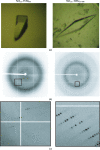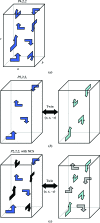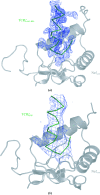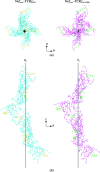Pseudo-merohedral twinning and noncrystallographic symmetry in orthorhombic crystals of SIVmac239 Nef core domain bound to different-length TCRzeta fragments
- PMID: 20124696
- PMCID: PMC2815668
- DOI: 10.1107/S090744490904880X
Pseudo-merohedral twinning and noncrystallographic symmetry in orthorhombic crystals of SIVmac239 Nef core domain bound to different-length TCRzeta fragments
Abstract
HIV/SIV Nef mediates many cellular processes through interactions with various cytoplasmic and membrane-associated host proteins, including the signalling zeta subunit of the T-cell receptor (TCRzeta). Here, the crystallization strategy, methods and refinement procedures used to solve the structures of the core domain of the SIVmac239 isolate of Nef (Nef(core)) in complex with two different TCRzeta fragments are described. The structure of SIVmac239 Nef(core) bound to the longer TCRzeta polypeptide (Leu51-Asp93) was determined to 3.7 A resolution (R(work) = 28.7%) in the tetragonal space group P4(3)2(1)2. The structure of SIVmac239 Nef(core) in complex with the shorter TCRzeta polypeptide (Ala63-Arg80) was determined to 2.05 A resolution (R(work) = 17.0%), but only after the detection of nearly perfect pseudo-merohedral crystal twinning and proper assignment of the orthorhombic space group P2(1)2(1)2(1). The reduction in crystal space-group symmetry induced by the truncated TCRzeta polypeptide appears to be caused by the rearrangement of crystal-contact hydrogen-bonding networks and the substitution of crystallographic symmetry operations by similar noncrystallographic symmetry (NCS) operations. The combination of NCS rotations that were nearly parallel to the twin operation (k, h, -l) and a and b unit-cell parameters that were nearly identical predisposed the P2(1)2(1)2(1) crystal form to pseudo-merohedral twinning.
Figures









Similar articles
-
Zeta chain of the T-cell receptor interacts with nef of simian immunodeficiency virus and human immunodeficiency virus type 2.J Virol. 1998 Dec;72(12):9827-34. doi: 10.1128/JVI.72.12.9827-9834.1998. J Virol. 1998. PMID: 9811718 Free PMC article.
-
The T-cell receptor zeta chain contains two homologous domains with which simian immunodeficiency virus Nef interacts and mediates down-modulation.J Virol. 2000 Apr;74(7):3273-83. doi: 10.1128/jvi.74.7.3273-3283.2000. J Virol. 2000. PMID: 10708444 Free PMC article.
-
The crystal structure of HIV-1 Nef protein bound to the Fyn kinase SH3 domain suggests a role for this complex in altered T cell receptor signaling.Structure. 1997 Oct 15;5(10):1361-72. doi: 10.1016/s0969-2126(97)00286-4. Structure. 1997. PMID: 9351809
-
Interactions of HIV-1 NEF with cellular signal transducing proteins.Front Biosci. 2000 Feb 1;5:D268-83. doi: 10.2741/renkema. Front Biosci. 2000. PMID: 10704155 Review.
-
HIV and SIV Nef modulate signal transduction and protein sorting in T cells.Cold Spring Harb Symp Quant Biol. 1999;64:453-63. doi: 10.1101/sqb.1999.64.453. Cold Spring Harb Symp Quant Biol. 1999. PMID: 11232322 Review. No abstract available.
Cited by
-
Effector kinase coupling enables high-throughput screens for direct HIV-1 Nef antagonists with antiretroviral activity.Chem Biol. 2013 Jan 24;20(1):82-91. doi: 10.1016/j.chembiol.2012.11.005. Chem Biol. 2013. PMID: 23352142 Free PMC article.
-
Efficient Nef-mediated downmodulation of TCR-CD3 and CD28 is associated with high CD4+ T cell counts in viremic HIV-2 infection.J Virol. 2012 May;86(9):4906-20. doi: 10.1128/JVI.06856-11. Epub 2012 Feb 15. J Virol. 2012. PMID: 22345473 Free PMC article.
-
Acute Viral Escape Selectively Impairs Nef-Mediated Major Histocompatibility Complex Class I Downmodulation and Increases Susceptibility to Antiviral T Cells.J Virol. 2015 Dec 4;90(4):2119-26. doi: 10.1128/JVI.01975-15. Print 2016 Feb 15. J Virol. 2015. PMID: 26637459 Free PMC article.
-
Self-association of the Lentivirus protein, Nef.Retrovirology. 2010 Sep 23;7:77. doi: 10.1186/1742-4690-7-77. Retrovirology. 2010. PMID: 20863404 Free PMC article.
-
Endocytic sorting motif interactions involved in Nef-mediated downmodulation of CD4 and CD3.Nat Commun. 2017 Sep 5;8(1):442. doi: 10.1038/s41467-017-00481-z. Nat Commun. 2017. PMID: 28874665 Free PMC article.
References
-
- Adams, P. D., Grosse-Kunstleve, R. W., Hung, L.-W., Ioerger, T. R., McCoy, A. J., Moriarty, N. W., Read, R. J., Sacchettini, J. C., Sauter, N. K. & Terwilliger, T. C. (2002). Acta Cryst. D58, 1948–1954. - PubMed
-
- Arien, K. K. & Verhasselt, B. (2008). Curr. HIV Res.6, 200–208. - PubMed
-
- Arold, S., Franken, P., Strub, M. P., Hoh, F., Benichou, S., Benarous, R. & Dumas, C. (1997). Structure, 5, 1361–1372. - PubMed
-
- Bell, I., Ashman, C., Maughan, J., Hooker, E., Cook, F. & Reinhart, T. A. (1998). J. Gen. Virol.79, 2717–2727. - PubMed
-
- Britton, D. (1972). Acta Cryst. A28, 296–297.
Publication types
MeSH terms
Substances
Grants and funding
LinkOut - more resources
Full Text Sources

